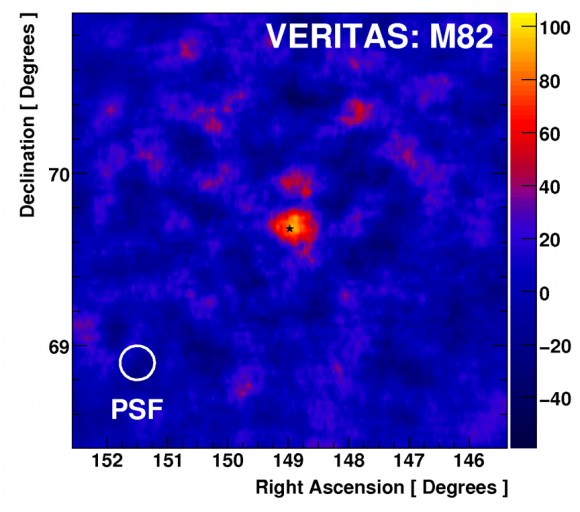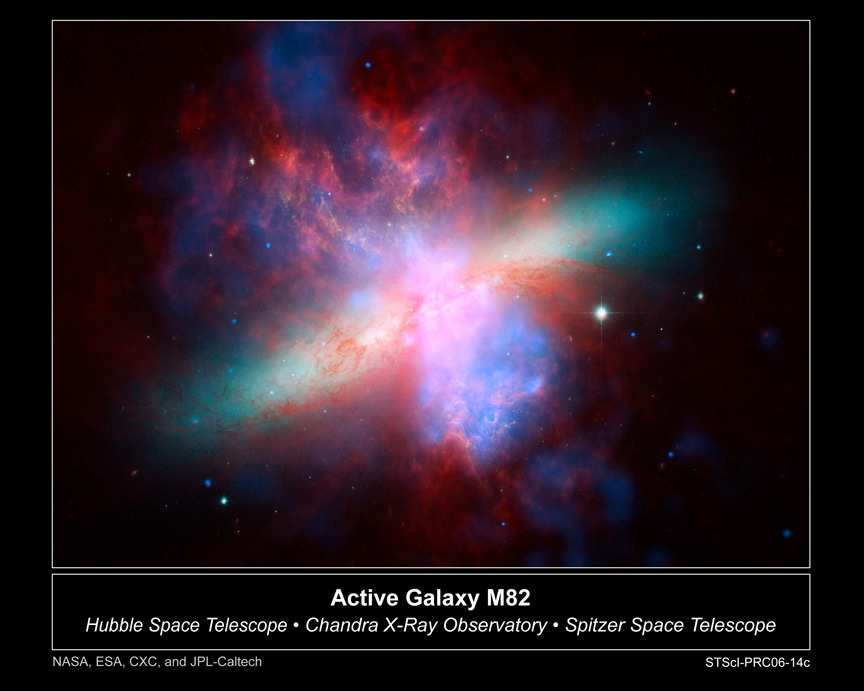What accelerates cosmic rays to nearly the speed of light? Astronomer have pondered that question for nearly 100 years, and now new evidence supports a theory held for two decades that cosmic rays likely are powered by exploding stars and stellar winds. “This discovery has been predicted for almost 20 years, but until now no instrument was sensitive enough to see it,” said Wystan Benbow, an astrophysicist at the Smithsonian Astrophysical Observatory who coordinated this project for the Very Energetic Radiation Imaging Telescope Array System (VERITAS) collaboration.
Nearly 100 years ago, scientists detected the first signs of cosmic rays, which are actually not rays or beams but subatomic particles (mostly protons) that zip through space at nearly the speed of light. The most energetic cosmic rays hit with the punch of a 98-mph fastball, even though they are smaller than an atom. Astronomers questioned what natural force could accelerate particles to such a speed.
The rarest cosmic rays carry over 100 billion times as much energy as generated by any particle accelerator on Earth. Astronomers have devised ingenious methods for detecting cosmic rays that hit Earth’s atmosphere. However, detecting cosmic rays from a distance requires much more effort.

VERITAS has found new evidence for cosmic rays in the “Cigar Galaxy,” also known as Messier 82 (M82), which is located 12 million light-years from Earth in the direction of the constellation Ursa Major, which strongly support the long-held theory that supernovae and stellar winds from massive stars are the dominant accelerators of cosmic-ray particles.
Galaxies with high levels of star formation like M82, also known as “starburst” galaxies, have large numbers of supernovae and massive stars. If the theory holds, then starburst galaxies should contain more cosmic rays than normal galaxies. The VERITAS discovery confirms that expectation, indicating that the cosmic-ray density in M82 is approximately 500 times the average density in our Galaxy, the Milky Way.
“This discovery provides fundamental insight into the origin of cosmic rays,” said Rene Ong, a professor of physics at the University of California, Los Angeles, and the spokesperson for the VERITAS collaboration.
Using gamma rays to infer cosmic rays
VERITAS could not detect M82’s cosmic rays directly because they are trapped within the Cigar Galaxy. Instead, VERITAS looked for clues to the presence of cosmic rays: gamma rays. Gamma rays are the most energetic form of light, far more powerful than ultraviolet light or even X-rays. When cosmic rays interact with interstellar gas and radiation within M82, they produce gamma rays, which can then escape their home galaxy and reach Earthbound detectors.
It took two years of dedicated data collection to tease out the faint signal coming from M82.
“We knew that the detection of M82 would have important scientific implications. As a result, we scheduled an exceptionally long exposure immediately after the experiment became fully operational” said Benbow. “The data needed to be meticulously analyzed to extract the gamma-ray signal, which is over a million times smaller than the background noise. Although the signal is only a tiny fraction of the data, we made many checks for possible bias and we are confident that the signal is genuine.”
“The detection of M82 indicates that the universe is full of natural particle accelerators, and as ground-based gamma-ray observatories continue to improve, further discoveries are inevitable.” said Martin Pohl, a professor of physics at Iowa State University who helped lead the study. A next-generation VHE gamma-ray observatory, the Advanced Gamma-ray Imaging System (AGIS), is already under development.
VERITAS is operated by a collaboration of more than 100 scientists from 22 different institutions in the United States, Ireland, England and Canada. Click here for more information on VERITAS.
Lead image caption: A composite of multi-wavelength images of the active galaxy M82 from Hubble, Chandra, and Spitzer. Credit: NASA, ESA, CXC, and JPL-Caltech


I posted the following on BadAstronomy, but I think it’s worth to be posted here, too:
“Talking of cosmic rays. There has been a paper recently that uncovers that one of the key-features of the cosmic ray energy spectrum is not due to any form of dark matter (what has been speculated) but just due to shock-acceleration at Supernova shock fronts:
adsabs.harvard.edu/abs/2009PhRvL.103f1101B”
This is also the reason, although I claimed otherwiese in another thread ( 😉 ), that the LHC will not destroy the earth.
The world is small. This guy studied in Bochum, Germany. Just where I am, now. This is awesome 🙂
Hey, is it just my Internet browser or is anyone else not seeing this image that should appear above, but only appears for a fleeting moment before disappearing:
http://www.universetoday.com/wp-content/uploads/2009/11/m82-580×463.jpg
No, in this article it disappears for me, too.
We’ve been having issues with “disappearing” images for the past week. If I re-insert the image enough times and hold my tongue just right, then the image sticks. Let me go try again….
Nancy,
Have you also noticed any correlation with the phases of the moon? Position of the planets?
The energy scales of cosmic rays is good for extremely high energy physics. Of course the problems are you have little control over the energy of the incident particle, and fluxes are random and low.
LC
ND, I suppose the moon makes a perfect shield that blocks cosmic rays. 😉
@Ivan3man
With the link http://www.universetoday.com/wp-content/uploads/2009/11/m82-580×463.jpg I’m just getting a 404 – not found
@Nancy – Thanks for the great article.
I’ve noticed some problems with my WordPress plugins the past week but have them resolved now. Feel free to email me any time you need to on technical issues.
http://ww.caspianit.co.uk is my technical blog.
@ Vedic,
That link to the JPG image was working until Nancy fixed the “disappearing” image issue, which is the same image as the first one now shown above.
The PR at the Harvard CfA also mentioned that another AGN galaxy, NGC 253, had been detected in VHE gamma rays along with M 82. Other suspected sources of extragalactic cosmic rays are M 87 (Vir A), NGC 5128 (Cen A), NGC 1275 (Per A), NGC 1316 (For A) and PGC 017116 (Pic A). Note that all candidates are also strong radio sources (hence the letter A designation).
Note that also all candidates seem to be AGN. Since those guys tend to have jets, it is not unlikely that they are a source of highly energetic cosmic rays, is it?
Just to add it 😉
A paper pertaining to cosmic rays from M 82 recently appeared here: http://arxiv.org/ftp/arxiv/papers/0911/0911.0873.pdf . Definitely this AGN galaxy is probably associated with UHE cosmic rays, as Dr Flimmer points out.